Xiaohui Hu
Improve LLM-as-a-Judge Ability as a General Ability
Feb 17, 2025



Abstract:LLM-as-a-Judge leverages the generative and reasoning capabilities of large language models (LLMs) to evaluate LLM responses across diverse scenarios, providing accurate preference signals. This approach plays a vital role in aligning LLMs with human values, ensuring ethical and reliable AI outputs that align with societal norms. Recent studies have raised many methods to train LLM as generative judges, but most of them are data consuming or lack accuracy, and only focus on LLM's judge ability. In this work, we regard judge ability as a general ability of LLM and implement a two-stage training approach, comprising supervised fine-tuning (SFT) warm-up and direct preference optimization (DPO) enhancement, to achieve judge style adaptation and improve judgment accuracy. Additionally, we introduce an efficient data synthesis method to generate judgmental content. Experimental results demonstrate that our approach, utilizing only about 2% to 40% of the data required by other methods, achieves SOTA performance on RewardBench. Furthermore, our training method enhances the general capabilities of the model by constructing complicated judge task, and the judge signals provided by our model have significantly enhanced the downstream DPO training performance of our internal models in our test to optimize policy model with Judge Model. We also open-source our model weights and training data to facilitate further research.
Yi-Lightning Technical Report
Dec 03, 2024



Abstract:This technical report presents Yi-Lightning, our latest flagship large language model (LLM). It achieves exceptional performance, ranking 6th overall on Chatbot Arena, with particularly strong results (2nd to 4th place) in specialized categories including Chinese, Math, Coding, and Hard Prompts. Yi-Lightning leverages an enhanced Mixture-of-Experts (MoE) architecture, featuring advanced expert segmentation and routing mechanisms coupled with optimized KV-caching techniques. Our development process encompasses comprehensive pre-training, supervised fine-tuning (SFT), and reinforcement learning from human feedback (RLHF), where we devise deliberate strategies for multi-stage training, synthetic data construction, and reward modeling. Furthermore, we implement RAISE (Responsible AI Safety Engine), a four-component framework to address safety issues across pre-training, post-training, and serving phases. Empowered by our scalable super-computing infrastructure, all these innovations substantially reduce training, deployment and inference costs while maintaining high-performance standards. With further evaluations on public academic benchmarks, Yi-Lightning demonstrates competitive performance against top-tier LLMs, while we observe a notable disparity between traditional, static benchmark results and real-world, dynamic human preferences. This observation prompts a critical reassessment of conventional benchmarks' utility in guiding the development of more intelligent and powerful AI systems for practical applications. Yi-Lightning is now available through our developer platform at https://platform.lingyiwanwu.com.
Yi: Open Foundation Models by 01.AI
Mar 07, 2024



Abstract:We introduce the Yi model family, a series of language and multimodal models that demonstrate strong multi-dimensional capabilities. The Yi model family is based on 6B and 34B pretrained language models, then we extend them to chat models, 200K long context models, depth-upscaled models, and vision-language models. Our base models achieve strong performance on a wide range of benchmarks like MMLU, and our finetuned chat models deliver strong human preference rate on major evaluation platforms like AlpacaEval and Chatbot Arena. Building upon our scalable super-computing infrastructure and the classical transformer architecture, we attribute the performance of Yi models primarily to its data quality resulting from our data-engineering efforts. For pretraining, we construct 3.1 trillion tokens of English and Chinese corpora using a cascaded data deduplication and quality filtering pipeline. For finetuning, we polish a small scale (less than 10K) instruction dataset over multiple iterations such that every single instance has been verified directly by our machine learning engineers. For vision-language, we combine the chat language model with a vision transformer encoder and train the model to align visual representations to the semantic space of the language model. We further extend the context length to 200K through lightweight continual pretraining and demonstrate strong needle-in-a-haystack retrieval performance. We show that extending the depth of the pretrained checkpoint through continual pretraining further improves performance. We believe that given our current results, continuing to scale up model parameters using thoroughly optimized data will lead to even stronger frontier models.
Supporting Medical Relation Extraction via Causality-Pruned Semantic Dependency Forest
Aug 29, 2022

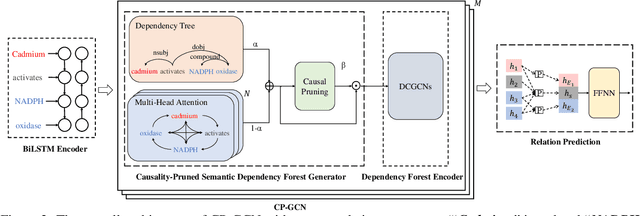
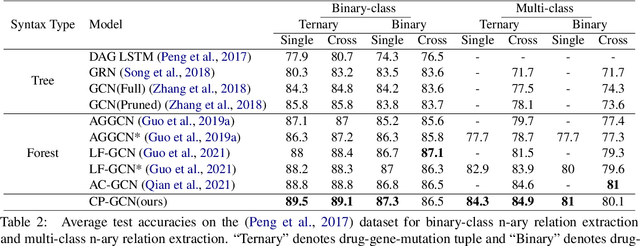
Abstract:Medical Relation Extraction (MRE) task aims to extract relations between entities in medical texts. Traditional relation extraction methods achieve impressive success by exploring the syntactic information, e.g., dependency tree. However, the quality of the 1-best dependency tree for medical texts produced by an out-of-domain parser is relatively limited so that the performance of medical relation extraction method may degenerate. To this end, we propose a method to jointly model semantic and syntactic information from medical texts based on causal explanation theory. We generate dependency forests consisting of the semantic-embedded 1-best dependency tree. Then, a task-specific causal explainer is adopted to prune the dependency forests, which are further fed into a designed graph convolutional network to learn the corresponding representation for downstream task. Empirically, the various comparisons on benchmark medical datasets demonstrate the effectiveness of our model.
Disentangle and Remerge: Interventional Knowledge Distillation for Few-Shot Object Detection from A Conditional Causal Perspective
Aug 26, 2022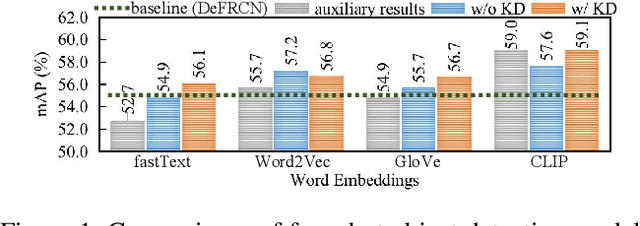


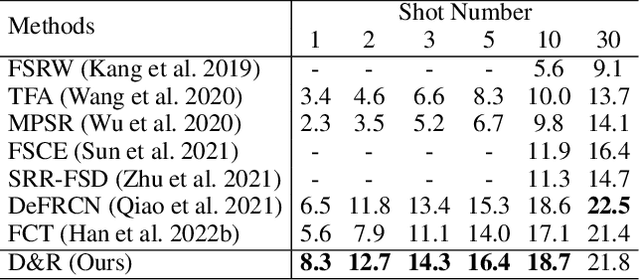
Abstract:Few-shot learning models learn representations with limited human annotations, and such a learning paradigm demonstrates practicability in various tasks, e.g., image classification, object detection, etc. However, few-shot object detection methods suffer from an intrinsic defect that the limited training data makes the model cannot sufficiently explore semantic information. To tackle this, we introduce knowledge distillation to the few-shot object detection learning paradigm. We further run a motivating experiment, which demonstrates that in the process of knowledge distillation the empirical error of the teacher model degenerates the prediction performance of the few-shot object detection model, as the student. To understand the reasons behind this phenomenon, we revisit the learning paradigm of knowledge distillation on the few-shot object detection task from the causal theoretic standpoint, and accordingly, develop a Structural Causal Model. Following the theoretical guidance, we propose a backdoor adjustment-based knowledge distillation method for the few-shot object detection task, namely Disentangle and Remerge (D&R), to perform conditional causal intervention toward the corresponding Structural Causal Model. Theoretically, we provide an extended definition, i.e., general backdoor path, for the backdoor criterion, which can expand the theoretical application boundary of the backdoor criterion in specific cases. Empirically, the experiments on multiple benchmark datasets demonstrate that D&R can yield significant performance boosts in few-shot object detection.
Vector Quantized Diffusion Model with CodeUnet for Text-to-Sign Pose Sequences Generation
Aug 19, 2022

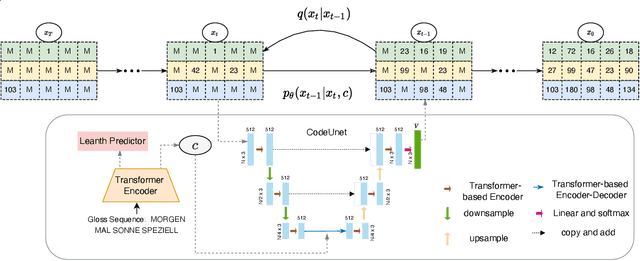

Abstract:Sign Language Production (SLP) aims to translate spoken languages into sign sequences automatically. The core process of SLP is to transform sign gloss sequences into their corresponding sign pose sequences (G2P). Most existing G2P models usually perform this conditional long-range generation in an autoregressive manner, which inevitably leads to an accumulation of errors. To address this issue, we propose a vector quantized diffusion method for conditional pose sequences generation, called PoseVQ-Diffusion, which is an iterative non-autoregressive method. Specifically, we first introduce a vector quantized variational autoencoder (Pose-VQVAE) model to represent a pose sequence as a sequence of latent codes. Then we model the latent discrete space by an extension of the recently developed diffusion architecture. To better leverage the spatial-temporal information, we introduce a novel architecture, namely CodeUnet, to generate higher quality pose sequence in the discrete space. Moreover, taking advantage of the learned codes, we develop a novel sequential k-nearest-neighbours method to predict the variable lengths of pose sequences for corresponding gloss sequences. Consequently, compared with the autoregressive G2P models, our model has a faster sampling speed and produces significantly better results. Compared with previous non-autoregressive G2P methods, PoseVQ-Diffusion improves the predicted results with iterative refinements, thus achieving state-of-the-art results on the SLP evaluation benchmark.
MME-CRS: Multi-Metric Evaluation Based on Correlation Re-Scaling for Evaluating Open-Domain Dialogue
Jun 19, 2022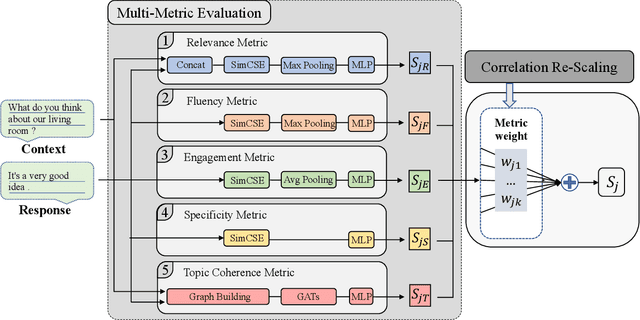
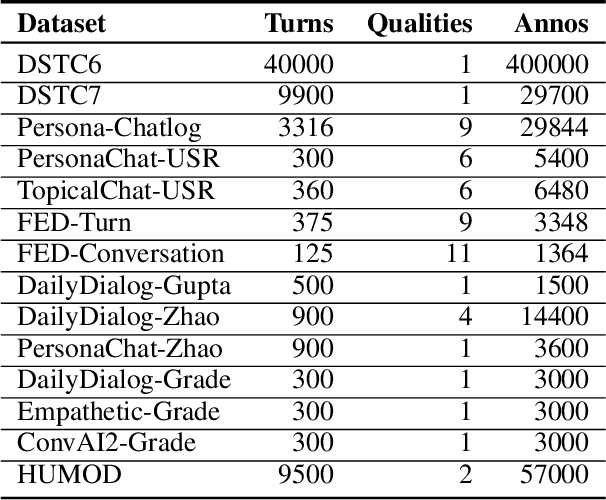
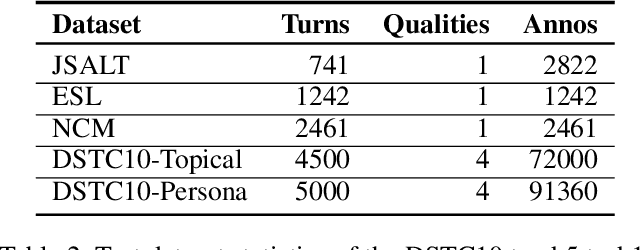

Abstract:Automatic open-domain dialogue evaluation is a crucial component of dialogue systems. Recently, learning-based evaluation metrics have achieved state-of-the-art performance in open-domain dialogue evaluation. However, these metrics, which only focus on a few qualities, are hard to evaluate dialogue comprehensively. Furthermore, these metrics lack an effective score composition approach for diverse evaluation qualities. To address the above problems, we propose a Multi-Metric Evaluation based on Correlation Re-Scaling (MME-CRS) for evaluating open-domain dialogue. Firstly, we build an evaluation metric composed of 5 groups of parallel sub-metrics called Multi-Metric Evaluation (MME) to evaluate the quality of dialogue comprehensively. Furthermore, we propose a novel score composition method called Correlation Re-Scaling (CRS) to model the relationship between sub-metrics and diverse qualities. Our approach MME-CRS ranks first on the final test data of DSTC10 track5 subtask1 Automatic Open-domain Dialogue Evaluation Challenge with a large margin, which proved the effectiveness of our proposed approach.
Multiple Fusion Adaptation: A Strong Framework for Unsupervised Semantic Segmentation Adaptation
Dec 01, 2021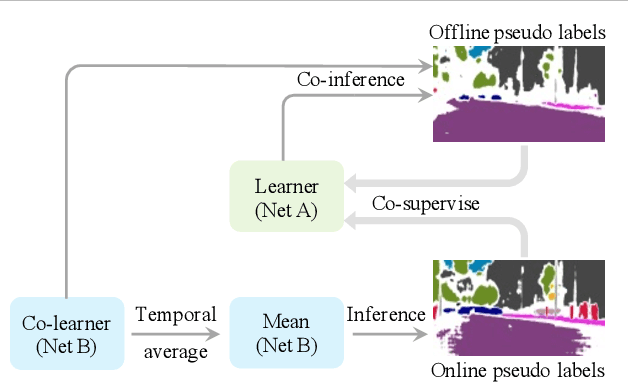

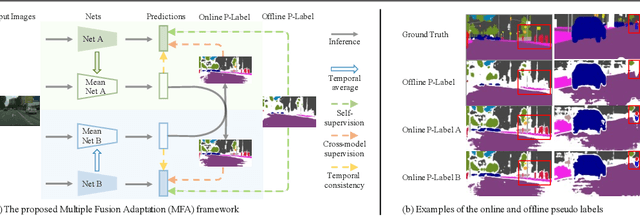

Abstract:This paper challenges the cross-domain semantic segmentation task, aiming to improve the segmentation accuracy on the unlabeled target domain without incurring additional annotation. Using the pseudo-label-based unsupervised domain adaptation (UDA) pipeline, we propose a novel and effective Multiple Fusion Adaptation (MFA) method. MFA basically considers three parallel information fusion strategies, i.e., the cross-model fusion, temporal fusion and a novel online-offline pseudo label fusion. Specifically, the online-offline pseudo label fusion encourages the adaptive training to pay additional attention to difficult regions that are easily ignored by offline pseudo labels, therefore retaining more informative details. While the other two fusion strategies may look standard, MFA pays significant efforts to raise the efficiency and effectiveness for integration, and succeeds in injecting all the three strategies into a unified framework. Experiments on two widely used benchmarks, i.e., GTA5-to-Cityscapes and SYNTHIA-to-Cityscapes, show that our method significantly improves the semantic segmentation adaptation, and sets up new state of the art (58.2% and 62.5% mIoU, respectively). The code will be available at https://github.com/KaiiZhang/MFA.
Cross Modification Attention Based Deliberation Model for Image Captioning
Sep 17, 2021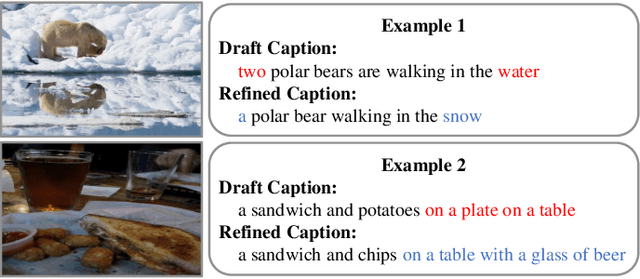
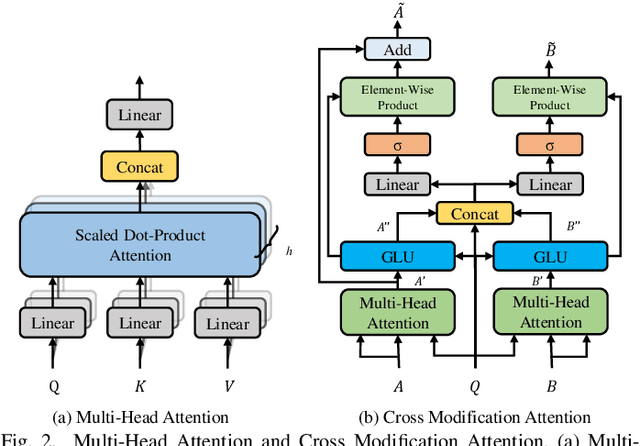
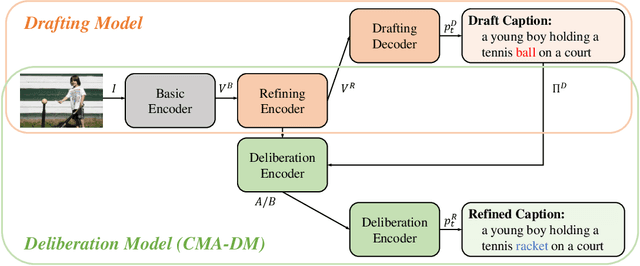
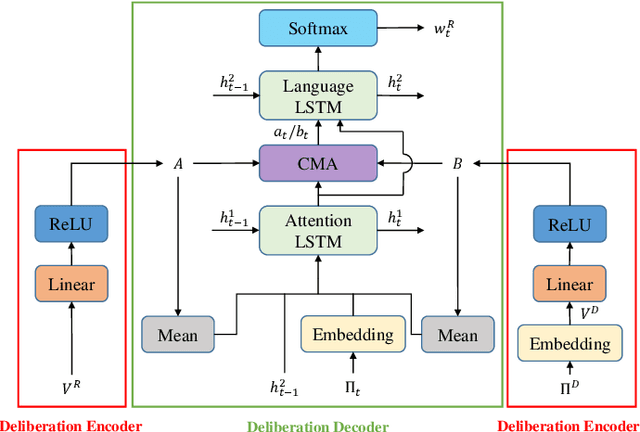
Abstract:The conventional encoder-decoder framework for image captioning generally adopts a single-pass decoding process, which predicts the target descriptive sentence word by word in temporal order. Despite the great success of this framework, it still suffers from two serious disadvantages. Firstly, it is unable to correct the mistakes in the predicted words, which may mislead the subsequent prediction and result in error accumulation problem. Secondly, such a framework can only leverage the already generated words but not the possible future words, and thus lacks the ability of global planning on linguistic information. To overcome these limitations, we explore a universal two-pass decoding framework, where a single-pass decoding based model serving as the Drafting Model first generates a draft caption according to an input image, and a Deliberation Model then performs the polishing process to refine the draft caption to a better image description. Furthermore, inspired from the complementarity between different modalities, we propose a novel Cross Modification Attention (CMA) module to enhance the semantic expression of the image features and filter out error information from the draft captions. We integrate CMA with the decoder of our Deliberation Model and name it as Cross Modification Attention based Deliberation Model (CMA-DM). We train our proposed framework by jointly optimizing all trainable components from scratch with a trade-off coefficient. Experiments on MS COCO dataset demonstrate that our approach obtains significant improvements over single-pass decoding baselines and achieves competitive performances compared with other state-of-the-art two-pass decoding based methods.
MvSR-NAT: Multi-view Subset Regularization for Non-Autoregressive Machine Translation
Aug 19, 2021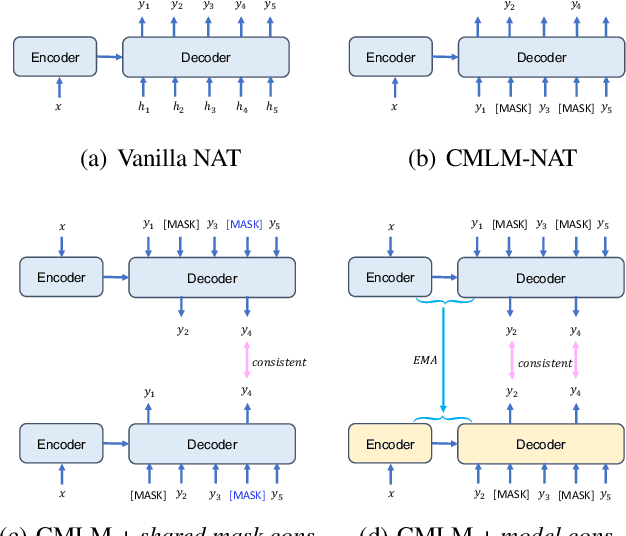

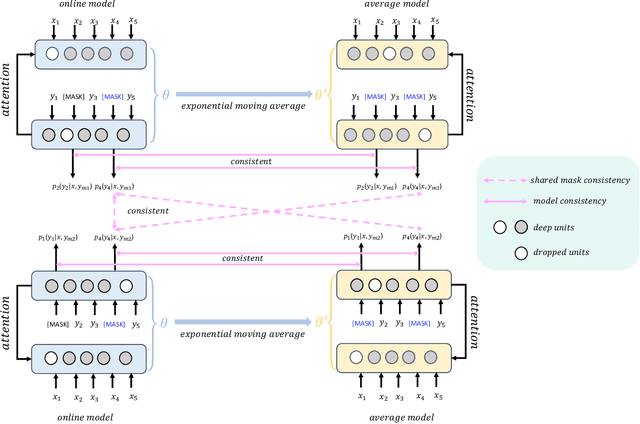
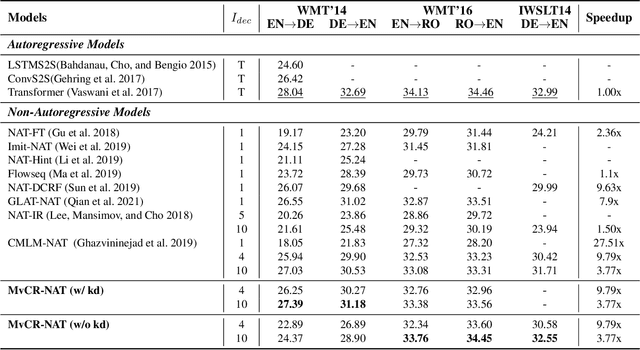
Abstract:Conditional masked language models (CMLM) have shown impressive progress in non-autoregressive machine translation (NAT). They learn the conditional translation model by predicting the random masked subset in the target sentence. Based on the CMLM framework, we introduce Multi-view Subset Regularization (MvSR), a novel regularization method to improve the performance of the NAT model. Specifically, MvSR consists of two parts: (1) \textit{shared mask consistency}: we forward the same target with different mask strategies, and encourage the predictions of shared mask positions to be consistent with each other. (2) \textit{model consistency}, we maintain an exponential moving average of the model weights, and enforce the predictions to be consistent between the average model and the online model. Without changing the CMLM-based architecture, our approach achieves remarkable performance on three public benchmarks with 0.36-1.14 BLEU gains over previous NAT models. Moreover, compared with the stronger Transformer baseline, we reduce the gap to 0.01-0.44 BLEU scores on small datasets (WMT16 RO$\leftrightarrow$EN and IWSLT DE$\rightarrow$EN).
 Add to Chrome
Add to Chrome Add to Firefox
Add to Firefox Add to Edge
Add to Edge